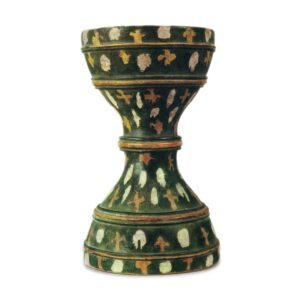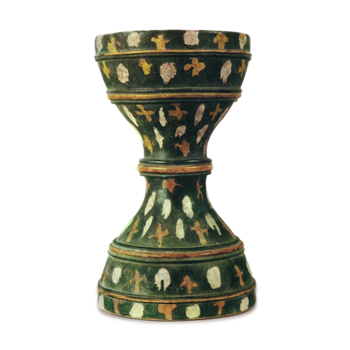
The Shosoin Repository contains a total of sixty-eight pieces of pottery, including fifty-seven pieces of colored glazed pottery commonly referred to as Shosoin sansai, ten pieces of Sue ware called Shosoin yaku jar yaku bawan and one piece of Sue ware called a blue spotted stone inkstone. In addition, there are 36 pottery shards and a few small pieces, all of which are well known as the world’s oldest pottery passed down to earth.
However, only fifty-six pieces of colored glazed ceramics, excluding the pagoda, are listed in the “Todaiji Tsunafu Joumi-zaibutsu Kanken Order” dated 1117 (Eternal 5), and it is thought that more ceramics existed in the beginning, since pottery fragments were already separated as damaged items at that time.
As is well known, the treasures in Shosoin were mainly collected by Empress Dowager Komyo on the 49th anniversary of Emperor Shomu’s death on June 21, 756 (Tempyo Shoho 8), and were presented to Todaiji Rujanabutsu in a collection of “national treasures” that had been bequeathed by the previous emperor. However, sansai (Sansai) and green-glazed ceramics were not among them. In the fourth year of Tenryaku (950), in the seventh month, the storehouse of Todaiji’s Amasa-in was damaged by a storm, and the offerings from the Amasa-in were moved to the southern end of the Shoso-in storehouse and sealed with rope seals. Later, in the 4th year of Eien (1116), important treasures from the southern storehouse were moved to the enclosure, but it is known from “Tsuna-fu Kurami ni Zaibutsu-kankemono Kanken-order” that the southern storehouse remained in the tsuna-fu style after that. In other words, the Shosoin sanzai, along with incense burners, water vases, mirrors, and musical instruments, were ceremonial furnishings originally housed in Kasausakuin and were moved from Todaiji in Tenryaku 4. Therefore, the origin of these items differs from that of the medicine jar, medicine bowl, and inkstone in Kitakura and the inkstone in Nakakura, respectively.
According to the inscriptions on these Sansai, green-glazed ceramics, they are thought to have been used in a number of major ceremonies, from the opening of the Great Buddha on April 9, Tenpyo-shoho 4, to Emperor Shoutoku’s visit to Todaiji on April 3, Jingo-keiun 2.
Among the Shosoin Sansai paintings, there is a green-and-white Nisai painting with an inscription on the bottom: “Kidoin sanseiyo-ban, Tenpyo Shoho 7-nen July 15, Todaiji Temple”, which is known to have been used for the Emperor Shomu’s visit to his mother’s palace, Chugu Gosaikai.
The name of the Shosoin collection of 57 Sansai paintings has been changed variously since the Heian period (794-1185). In the “Kurami-zairi-mokuroku” of Era 5, all items were classified as “Aoko-tubes and Aoko-bowls” except for “Aoko-tubes and Aoko-bottles,” and in the “Shosoin Gomotsu Mokuroku” of 1908, they were classified as “Porcelain towers and drums, porcelain bottles and bowls, and porcelain plates. In the survey conducted from 1962 to 1964, the items were changed to “pagodas, drums, vases, large dishes, large flat bowls, flat bowls, bowls and bowls,” but the large flat bowls correspond to the cups of Sue ware of the period, and the flat bowls to the grudges, and since the bottom of the cups have the characters “供「Youban」 on the bottom, they are used in this document as “boards” and bowls as “bowls. The quantity of items is therefore as follows.
The above vessels are all glazed with five types of glazes: Sansai, Nisai, yellow, white, and green glazes based on lead glazes. For more detailed information, please refer to “Shosoin Pottery” (Nihon Keizai Shimbun, Inc.), a report on the research conducted from 1962 to 1964, but for now I will give an overview based on this report.
Unlike Tang Sansai and Bohai Sansai wares, the base material is a slightly sandy clay with a slightly eggshell color due to the oxidative firing process, while those with a slightly reducing process have a grayish-white color. Only the base of the drum body is exceptionally fine and white. The Shosoin document “Zobutsu-sho Sakuributsu-cho” notes that the clay was brought from Katano, Osaka Prefecture, as zorashi clay, but in the same report, Kato Doji-moe, who collected and tested pottery clay from the Katano area, states that at first glance it appears to be a frog-like clay with many fine silica sand grains.
The molding was done on the potter’s wheel, using the wheel-thrown water-grinding method, and the style was extremely careful, with almost no visible wheel marks. The potter’s wheel is turned clockwise, and the surface of the vessel is adjusted clockwise after water-grinding. The finishing touches are made with a cloth, and everything is thin and precise.
The glaze is a low-fired glaze made of lead oxide as in Tang Sansai, but it was fired at a very high temperature of 800-850 degrees Celsius, judging from the tone of the glaze. The glaze was carefully applied with a brush, and while the glaze application on Tang Sansai was done quickly, the brush strokes were slow and awkward. The order of glaze application is green glaze first, followed by yellow glaze, and finally the spaces are filled with white glaze. The white glaze has a light green tinge, which is thought to be due to the fact that the brush used to apply the green glaze was not thoroughly washed. The Shosoin Sansai painting technique is unique to Japan, and does not have any affixed designs like those of Tang Sansai paintings. The most common type of sansai is called “deer pattern,” which consists of several staggered layers of green-glazed arcs, usually with yellow glaze at the intersections of the green-glazed arcs. In sansai, the yellow glaze is usually applied at the intersections of the Ryokuyu arcs. Other types include those that look like a mountain path, those with a flowing glaze with stripes, and those with a hemp-leaf style. In sansai, green and yellow are painted in a semicircular pattern in four directions in succession. Even in the case of green-glazed single-color wares, the outer surface of bowls is green and the inner surface white, while in the case of bowls, both the inner and outer surfaces are glazed green, and so on. Shosoin Sansai wares are first unglazed. The temperature of unglazing is about 50 to 100 degrees higher than the melting temperature of the glaze. The underglaze color of some pieces, such as nisai large dishes, green-glazed bowls, and yellow-glazed arms, shows the Gohon (lit. “fire cord”) produced when fired by reduction firing, and the underglaze color of nisai memorial tablets shows a pronounced hidasuki, indicating that the unglazing was done before glazing. The presence of eye marks indicates that firing after glazing was done in layers. The bowls are made of trident tochin, and the platters are made of crown-shaped ring douchin. The location of the Shosoin Sansai wares is unknown because the kiln site has not yet been discovered, but it is not difficult to imagine that they were fired in the vicinity of Todaiji Temple. All Shosoin sansai with green glaze were made in Japan.
The following is a breakdown of the medicine jars and bowls from the Hokura warehouse and the inkstone with wind characters from the Nakakura warehouse.
There are a total of ten complete sets of medicine jars and bowls, including one each of vanishing jar, Ebisu salt jar, and Chikuzu jar, five medicine jars, and two medicine bowls, as well as 22 pieces of Sue ware and one piece of earthenware discovered in Kitakura during the clearance of medicinal materials in 1947. The Sue ware shards, when joined together, make up four medicine jar lids, one cup with an “uchi” mark on the outside, and one medicine arm mouth rim sherd. The shape of the earthenware vessel is unknown due to the small size of the sherds. The above three types of jars are all large, short-necked vases, and their workmanship is superior to that of other types of medicine jars. The first two are common short-necked jars with lids, and the characteristics of the base and the shape of the fired vessels indicate that they were fired at the Tōyū kiln in the southern part of Osaka. The jar is particularly large in size and outstanding in execution, and differs from the glazed jar in that the mouth rim is turned outward in the shape of a trumpet. The Ebisu salt jar is slightly outwardly turned. However, many short-necked jars with outwardly turned mouth rims were fired at the Tōyū kiln, and there is a strong possibility that the Jigatsu jar was made at the same kiln. The other five pots, mainly rather large ones, were kept together and varied in size, including some with mouth rims turned outward, some upright, and some with flat bottoms without elevations, but judging from the construction of the lids, they too were probably produced at the Tōeup kiln. The two bowls and shards are similar, but only the cup marked with the character “uchi” has a grayish-white, sandy base and is somewhat different in style from the other wares. The inkstone in the middle storehouse, mounted on a hexagonal base with a woodblock-engraving design and set in a blue-red stone, is a typical Sue ware inkstone with fūji characters.
As described above, the Shosoin ceramics in the northern and central storehouses differ greatly in character in that the Sue ware in the northern storehouse was produced using tribute from the Izumi province, such as from the Tōyū kilns, while the colored glazed ceramics in the southern storehouse were produced in the central government-run workshops.



